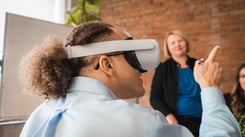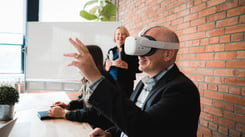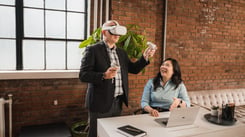Gone are the days when architectural firms relied solely on flat blueprints, static 3D models, and concept art to share their vision. The integration of Virtual Reality (VR) into architectural client presentations allows architects to offer immersive, interactive experiences that bring projects to life before the first brick is even laid. This shift not only captivates the attention of potential clients but also provides a clearer understanding of complex designs and spatial relationships within a proposed structure, even to those with no design experience.
VR for architectural firms is not just a novelty; it represents a transformative approach to engaging clients. By donning a VR headset, clients can walk through a virtual model of their project, experiencing the scale, texture, and lighting in a way traditional methods cannot match. This level of interactivity fosters a deeper connection to the project, often becoming a deciding factor in winning over clients. With VR for architectural firms, you can stand out from the competition.
Enhancing Visualization and Client Engagement Through VR
Virtual Reality elevates the client's experience from passive observation to active participation. Through VR, architects can present multiple design alternatives quickly and effectively, allowing clients to make informed decisions based on a realistic representation of the final product. This hands-on approach not only boosts client confidence in the architect's capabilities but also encourages a collaborative relationship where feedback is immediate, and changes can be visualized on the spot.
Furthermore, VR technology can dramatically increase client engagement. Instead of imagining the end result from 2D renderings, clients can virtually inhabit the space, exploring every corner and feature as if they were physically present. This level of engagement makes a presentation more memorable and often leads to a stronger emotional attachment to the project, which is a powerful tool in competitive pitches.

Realizing the ROI: Cost Benefits of Implementing VR in Architecture
Adopting VR technology may seem like a significant upfront investment, but the return on investment (ROI) can be substantial. First, VR reduces the need for costly physical models and extensive prototyping. It also streamlines the design process by identifying potential issues early on, thus avoiding expensive changes during construction. In addition, the wow factor of VR presentations can lead to more successful pitches and a higher conversion rate of prospects into clients, directly impacting the firm's bottom line.
Moreover, the use of VR can lead to greater efficiency in the design development phase. Architects can quickly iterate designs and receive feedback, reducing the time spent on revisions. By improving communication with clients and minimizing misunderstandings, VR can result in a smoother project flow and lower operational costs, contributing positively to the firm's ROI.
While most people think getting started with VR means investing in expensive headsets and tech, you probably already have the tools you need to get started with VR. With VR software such as Yulio, you can view VR experiences using a mobile phone or on a computer. You can experiment with VR using these devices to see how engaging you find the experiences. After you can decide if you want to invest in a VR headset for your firm. We have a guide to the best headset for architecture if you choose to go this route, including several affordable options.

The Meta Quest line is a fairly affordable line of standalone VR headsets
Case Studies: Architectural Firms Winning with VR
Real-world examples of architectural firms utilizing VR technology demonstrate their effectiveness in winning clients and projects. For instance, architect Danish Kurani who owns his own design studio uses VR both with the architects on his team and with clients. He views design proposals from his architects in VR and discusses practical options for their projects. He then takes clients on VR tours to get feedback on the design his team has created. In an interview, he says “They’re really appreciative of being able to see it this way as opposed to looking at abstract black and white lines on a floor plan. They’re really able to immerse themselves.”
Examples like these show that VR not only helps secure the projects but also enhances their reputation for innovation and client engagement. You can also see how VR can cater to diverse project scales and types, from residential to restoration, proving its versatility and wide-ranging benefits in the field of architecture.
Future Trends: How VR is Shaping the Architecture Industry
As VR technology continues to advance, its impact on the architecture industry is poised to deepen. Future trends suggest a move towards even more immersive and collaborative virtual environments where architects, clients, and stakeholders can interact with designs in real time, regardless of their physical location. This could revolutionize not only presentations but also the entire design and construction process, fostering global collaboration and innovation.
Moreover, the integration of VR with other emerging technologies, such as artificial intelligence and augmented reality, could lead to smarter design systems where virtual environments respond and adapt to user input, further enhancing the design experience. As these technologies mature, architectural firms that embrace VR will find themselves at the forefront of the industry, offering innovative services that distinguish them from competitors and attract clients looking for the next level of architectural design and presentation.






